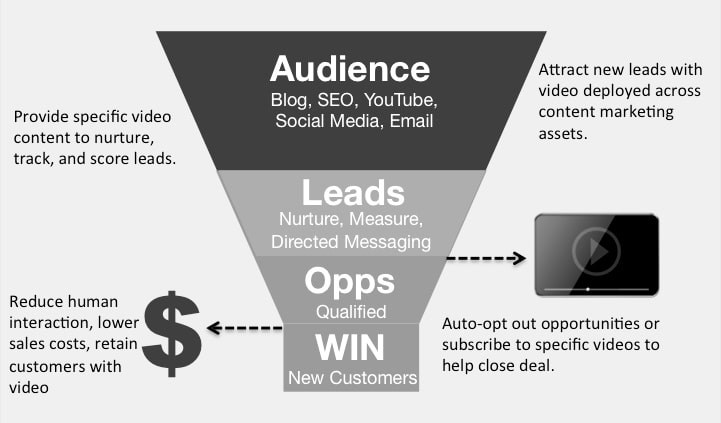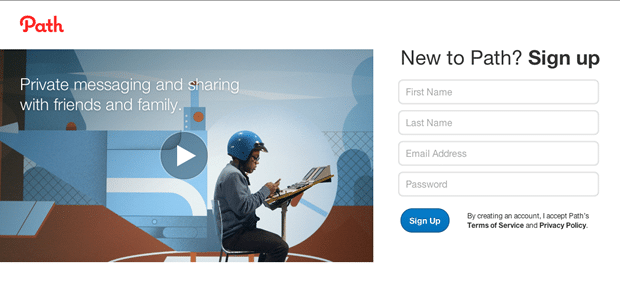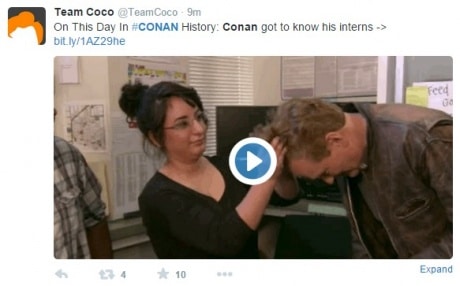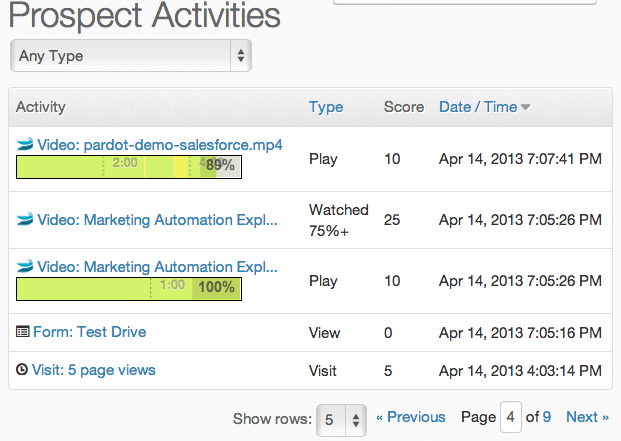Until recently, content marketing has been centered around static content like ebooks, white papers, case studies, blog posts, etc. These assets are great, but they provide little insight on how contacts are engaging with the content. Like which paragraph from a blog post was most popular, and what chapter in the ebook was most read. Video speaks to us and gives us detailed information about how contacts are engaging with our brand.
By integrating video with marketing automation software, you can gain infinitely more insight into your potential customers and more easily convert viewers into leads. In this post we will break down ways and reasons why you should connect your video to marketing automation and review video software designed for marketing. YouTube is a great strategy for building a brand, but by itself, its horrible for creating a sustainable demand generation business.
“Video speaks to us providing insights into prospect engagement”
The possibilities are endless with premium video hosting, especially connected to a video marketing platform. With player-level analytics, you can tell if someone finished watching the video, if he/she clicked on the call to action, and countless more details. It’s not enough to just upload to YouTube, which only gives you basic play analytics, which can only help you to a certain degree. In this post, we will be sure to cover how to best leverage marketing automation together with video to understand the general behavior of your customers, and determine how to best pull them through the funnel.
Why focus on video?
- 36% annual increase in sales due to video used in marketing.
- Videos appear in 70% of the Top 100 search listings
- Websites with video hold the viewer’s attention 2X more than sites that don’t have video.
- Websites with video are 53% more likely to appear on the first page of search results.
What type of data can you get from video?
- Video Play Data – Did the viewer complete the video? How much did they watch?
- In-Video Behavior – Bookmarks/TOC, Annotations, Quizzes, Interaction Data
- A/B Testing – Which version of a video performs better? Video vs Thumbnail testing
- General Behavior – Did the same contact return to the video? What other videos did they watch?
“5% of prospects are ready to make a purchase upon initial contact.” – Source: HubSpot
How Video Impacts The Marketing Funnel
 Measuring viewer behavior can give you a clear picture of where a prospect is in the buying cycle. Are the videos the prospect watched showing a pattern of buying behavior? Is the same video being watch over and over again? Connecting your video content to marketing automation software will give you answers to these important questions and ultimately reduce the cost of sale.
Measuring viewer behavior can give you a clear picture of where a prospect is in the buying cycle. Are the videos the prospect watched showing a pattern of buying behavior? Is the same video being watch over and over again? Connecting your video content to marketing automation software will give you answers to these important questions and ultimately reduce the cost of sale.
Video can be used in all stages of the marketing funnel. Shorter video clips at the top of the funnel, gradually increasing to more meaty videos as the contact progresses. Positioning the correct video content relative to where a contact is in the funnel is important to reducing human interaction and ultimately lowering the cost of sale.
Video on your landing pages
 This is one of the most common strategies because it quickly increases engagement and conversion rates. With marketing automation software, you can embed any video player object directly into a landing page. You can easily get play data (i.e. did the viewer play the video? What was the length of completion?) and tie that to actions like nurture tracks.
This is one of the most common strategies because it quickly increases engagement and conversion rates. With marketing automation software, you can embed any video player object directly into a landing page. You can easily get play data (i.e. did the viewer play the video? What was the length of completion?) and tie that to actions like nurture tracks.
Video in your HTML emails
This is an increasingly popular strategy and it can be an effective, unique way to run an email campaign. Using a Video Marketing Platform that’s integrated with your marketing automation provider, you can grab the thumbnail object and drag that into your email template. When it’s clicked, your video will automatically play on a unique landing page. You won’t want every email to have an embedded video, but it can be a powerful strategy if used sparingly.
Video on your website
This is just what it sounds like–embedding video with text on your website, to support the text or a general message of your website. With a YouTube embed code, there’s no real way to know if the video has been played. But with a premium video solution, you can capture valuable engagement data and video behavior. For example, if out of the 10,000 people that visited your home page this month, you know that 200 people played the video through the 30-second mark. With that information, you can set up a nurture track, specifically target those viewers, and provide them with relevant content.
When your videos get embedded and shared across the web

Example: Video playing on the Twitter Card.
It may seem obvious, but you want to know where your video is being embedded and shared. With a premium video solution, you can track engagement anywhere the player is embedded because you’ll have a link that goes back to your video’s URL, as well as the marketing automation cookie code, which can extend your power and visibility across the web. For example, if your video is picked up in a blog that supports an article, you’ll know that, and you can get the data.
Converting and engaging leads with your video
Lead gating is one of the most common forms of in-video call to action. You may use an in-video form or an actual landing page, or something like a table of contents or a quiz. With a premium video solution, you can carry video that has in-video calls to actions across the web, with detailed events that are mapped to your marketing software. For example, if a viewer completes a form to watch a video, that can trigger a nurture track.
Triggering lead scoring based on video engagement events

Example: Pardot Wistia Integration
Tagging certain points in the video can trigger a score, or impact a lead score, something that is becoming increasingly common in video marketing. This is one of the few things on this list that there is virtually no equivalent to with YouTube. You can pipe in engagement data points, tag certain points, and then trigger events based on those points. In terms of interactivity, you can even tag each topic in a table of contents, and track where your viewers click. This can be valuable in terms of nurturing leads, and also for knowing which content your viewers are really drawn to.
Using video lead generation with progressive profiling
One of the most non-invasive ways to collect data, progressive profiling is the ability to gradually complete a profile of a contact over time. For example, a viewer may watch a video and be prompted to fill out her name, email address, and phone number. The next time she returns to the site to watch a video, she’ll be asked for a few more pieces of information, and so on. This information can be piped directly into your marketing automation platform.
Trigger workflows and nurture tracks with your video
 Last but not least, something that has been mentioned throughout this post–you want to tie all of your content, and especially your video, into lead nurturing tracks. Additionally, you’ll always want to serve the video on a unique landing page, so you can track the viewer’s behavior.
Last but not least, something that has been mentioned throughout this post–you want to tie all of your content, and especially your video, into lead nurturing tracks. Additionally, you’ll always want to serve the video on a unique landing page, so you can track the viewer’s behavior.
This is post is an introduction to online video and marketing automation together. You may not be able to integrate all of these ideas at once, but as long as you’re focusing on your viewers’ behaviors and how to pull them through the funnel in an engaging way, you can’t go wrong. Stay tuned for a blog series that goes into much more detail about each one of these points!
For help and strategy advice with implementing a video strategy that incorporates marketing automation, contact our Strategy Team to schedule your free session.

